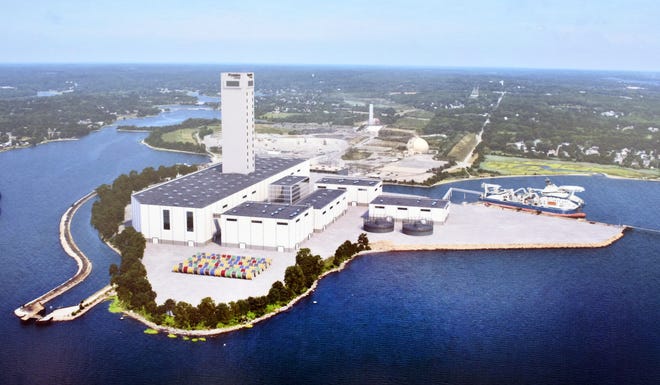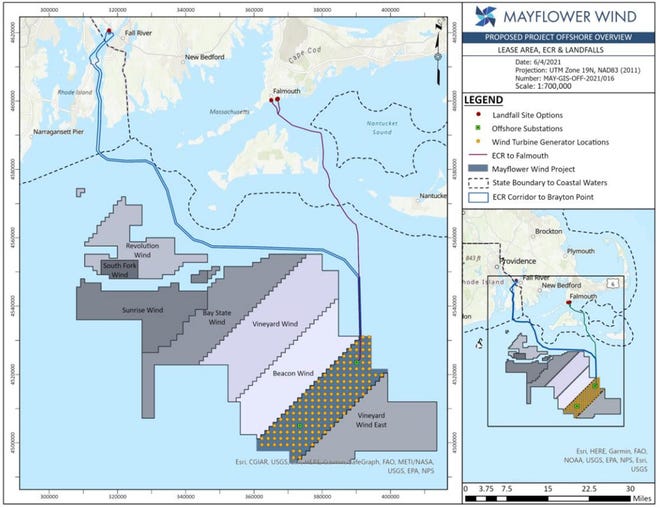Biden visiting Somerset to highlight power plant's move from 'Filthy Five' to clean future
President Joe Biden’s administration last month launched a federal-state partnership committed to growing the offshore wind power industry, with the specific aim of bolstering the supply chain needed to get wind farms up and running.
Brayton Point is a prime example of how energy production has evolved in recent decades. Once the home of a coal-fired facility so notorious for pollution it topped a list of the “Filthy Five” most environmentally harmful plants in the state, Brayton Point is now poised to be integral to the production and distribution of wind energy.
That transformation fits ideally with the Biden administration’s stated goal of producing more wind energy and consuming less fossil fuels.
Live updates:Biden to visit Somerset and his trip to Brayton Point
Let’s take a look at how that transformation started, and where it's going:
'The magic blue bin':Unfulfilled promise of single-stream recycling
Brayton Point's dirty history
Brayton Point Power Station was built by New England Power Co. on 306 acres of land in Somerset where the Taunton River meets Mount Hope Bay. Construction started in the late 1950s, with the plant commissioned in 1963. Its primary fuel source was coal brought in initially from mines in the United States and later by barge from Colombia – tens of thousands of tons, burned each week.
By 1969, the plant had three power-generating units burning coal and producing just over 1,000 megawatts – but with falling oil prices at the time, the units were converted to burning coal or oil. A fourth unit was constructed in the mid-1970s that burned either natural gas or oil, bringing the plant to its total of 1,537 megawatts, enough to power about 1.5 million homes.
Its first three turbines returned to burning coal in the early 1980s, and never went back to oil in its lifetime.
Even in its heyday, Brayton Point was the focus of environmental scrutiny. In 1971, John Rego, the retired director of the Rhode Island Department of Natural Resources, filed a complaint with the Environmental Protection Agency urging it to study the plant’s effect on aquatic life in Mount Hope Bay. The plant drew in water from the Taunton River and Mount Hope Bay, heated it and used the steam to power its turbines, then spat the water back out at a much higher temperature – environmentalists were concerned that the plant was making the water inhospitable to wildlife. Others had serious questions about the plant’s effect on air quality, with critics blaming the plant for high rates of asthma and one report claiming the plant was the top emitter of carbon dioxide in the northeast U.S.
Complaints would take decades to resolve. In 1995, a Rhode Island DEM study blamed Brayton Point for an “unprecedented loss” in Mount Hope Bay’s fish population of as much as 87%. The plant had been releasing 1.4 billion gallons of hot water back into the bay every day. The EPA cut short the plant’s permit to discharge water into the bay, kicking off a series of expensive improvements to the plant meant to reduce hazardous effects on the environment.
The plant's owners finished construction of 500-foot cooling towers in 2011 meant to reduce the temperature of the water before it was discharged. But the improvements were not to last. By October 2013, mere weeks after buying Brayton Point, the plant’s new owners, Energy Capital Partners, announced plans to shutter the plant within the next four years.
By May 2017, Brayton Point has received its last coal shipment. The plant was decommissioned and closed its doors. The power plant and new cooling towers were demolished two years later.

Brayton Point moves to wind energy
After its closing, and struggling with the loss of jobs and tax revenue, Somerset and state officials began the process of finding new uses for the 306-acre plot. The clear preference was its continued use as industrial land, but this time for the generation of clean energy.
The site is currently owned by Commercial Development Co., and is now known as Brayton Point Commerce Center.

What's next for Brayton Point:'People said this was never gonna happen': Brayton Point to reap benefits of offshore wind
Earlier this year, Brayton Point made significant strides in its transition from reliance on fossil-fuels to becoming part of the "green economy."
Mayflower Wind, which is developing an offshore wind farm south of Martha’s Vineyard and Nantucket, has plans to funnel its power into the energy grid via a substation at Brayton Point. Prysmian Group, an Italian company that specializes in manufacturing electrical cables, bought 47 acres at Brayton Point to construct a facility to make submarine power cables for both the Commonwealth Wind project and the Park City Wind project.
Take a virtual tour:Mayflower Wind's 3D model offers a glimpse at offshore wind project

Both projects represent investments of hundreds of millions of dollars, legislators have said, with the promise of local jobs.
The cable manufacturing facility is expected to open by early 2026.
LINK

No comments:
Post a Comment
Note: Only a member of this blog may post a comment.